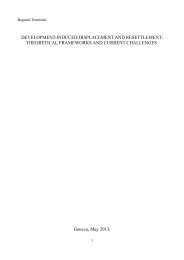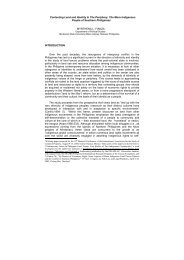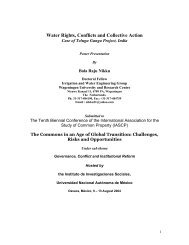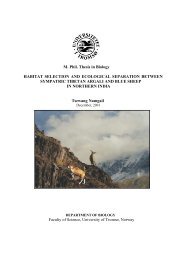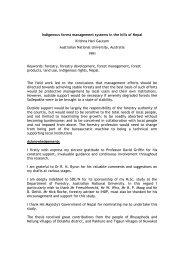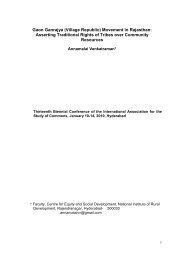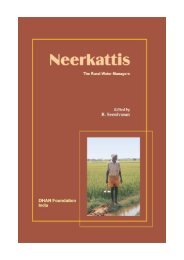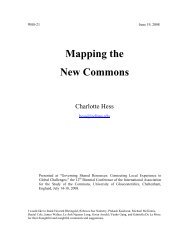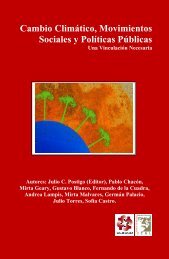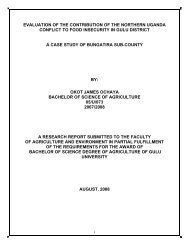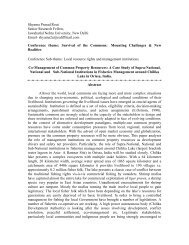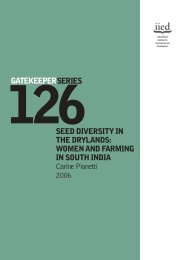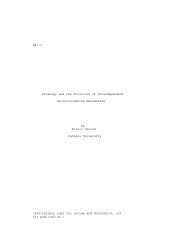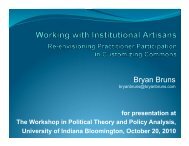Occupying the Land - Digital Library Of The Commons
Occupying the Land - Digital Library Of The Commons
Occupying the Land - Digital Library Of The Commons
Create successful ePaper yourself
Turn your PDF publications into a flip-book with our unique Google optimized e-Paper software.
As well as gardens, patches and stands of plant resources, salmon spawning streams andlakes, clam beds, gooseneck barnacle places, sea and sea lion hunting rocks, bear trails,halibut fishing grounds, beach salvage zones, and many o<strong>the</strong>r sites for harvesting animalresources were subject to ownership and control. Among <strong>the</strong> Nuu-chah-nulth, chumsalmon streams were particularly closely guarded against unauthorized use as this was <strong>the</strong>preferred species for smoke drying, but sockeye and coho fisheries were also owned.Sometimes a chief’s hahuulhi was exercised over one part of a creek, where he couldbuild fish traps, and ano<strong>the</strong>r chief’s hahuulhi would encompass ano<strong>the</strong>r part of <strong>the</strong> creek(Bouchard and Kennedy 1990: 23). Place names often reflected peoples’ associations andrelationships with an area. For example, a clam-beach called t’iimiiq (literally “move orthrow rocks aside”) on <strong>the</strong> south end of a beach on <strong>the</strong> northwest side of Vargas Island,according to George Louie and Peter Webster, was named after <strong>the</strong> practice of lookingafter <strong>the</strong> beach and <strong>the</strong> clam populations by moving <strong>the</strong> rocks aside (Bouchard andKennedy 1990: 386).<strong>The</strong> Kwakwaka'wakw system of ownership and stewardship of lands and places follows asimilar pattern to <strong>the</strong> Nuu-chah-nulth hahuulhi. Ownership and areas of use andoccupancy are associated with tribes and clans, or numayms, which are descent groupsbased on stipulated kinship. <strong>The</strong> clans or numayms, in between <strong>the</strong> social levels of afamily and tribe, are <strong>the</strong> fundamental unit of Kwakwaka'wakw society. A numaymconsists of one or more extended family groups all related to a common ancestor. Eachnumaym owned its own traditions, crests, privileges, family names, <strong>the</strong> right to sponsorpotlatches, <strong>the</strong> right to own houses in <strong>the</strong> winter village, and <strong>the</strong> right to own seasonalcamping spots for oolichan fishing, hunting and berry picking, fishing sites for nets, weirsor dipnetting, clam beds and hunting and ga<strong>the</strong>ring places. Thus <strong>the</strong> numaym linked <strong>the</strong>social structure with <strong>the</strong> land it inhabited. Kwakwaka'wakw land ownership, likehahuulhi, involves inheritability and restriction of access (Galois, 1994). In most cases,<strong>the</strong>re were effective social controls in place in which <strong>the</strong> system was so widely observedand respected, that trespassing would not be even thought of. Daisy Sewid-Smith andChief Adam Dick (pers. comm. 1996) explained that people very seldom crossed <strong>the</strong>boundaries into ano<strong>the</strong>r clan’s designated resource areas. “<strong>The</strong>y don't do that, comeacross [onto o<strong>the</strong>rs’ lands], cause <strong>the</strong>y know <strong>the</strong>y're owned. <strong>The</strong>y well respect eacho<strong>the</strong>r.” (Chief Adam Dick).<strong>The</strong> actual role of <strong>the</strong> clan hereditary chief and his family in managing <strong>the</strong> resources overwhich <strong>the</strong>y had jurisdiction is explained by Kwakwaka'wakw researchers, MartinWeinstein and Mike Morrell:Within traditional Kwakiutl [Kwakwaka'wakw] society resource management wasnot <strong>the</strong> realm of a class of professional specialists, but of <strong>the</strong> harvesting group and,in particular, <strong>the</strong> namima [numayam or clan] leadership. <strong>The</strong> namima was <strong>the</strong> unitof governance in traditional Kwakwaka'wakw society. <strong>The</strong> head chief was both <strong>the</strong>sovereign and <strong>the</strong> administrative head of <strong>the</strong> group. Each of <strong>the</strong> offices in <strong>the</strong>namima, <strong>the</strong> named and ranked positions, traced its origin and original place in <strong>the</strong>hierarchy to <strong>the</strong> ancestral creation myths. <strong>The</strong> connection with <strong>the</strong> creation mythsand <strong>the</strong> spirit world was <strong>the</strong> ultimate basis both for sovereignty and for <strong>the</strong> group's14



